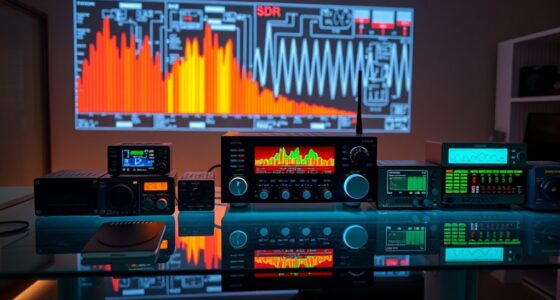If you’re looking for the best solar system models to make learning fun and accurate, I’ve found some excellent options. These models range from colorful, glow-in-the-dark toys for younger kids to detailed, assembly-ready kits for older learners. They feature realistic planets, movable parts, and engaging visual effects, helping kids understand space concepts better. Keep exploring, and I’ll share what makes each of these models a great choice for education.
Key Takeaways
- The models feature educational details, realistic sizes, and accurate planetary arrangements for effective learning.
- Glow-in-the-dark and projection functions enhance visual engagement and understanding of celestial mechanics.
- Suitable for children aged 3-12, with age-appropriate designs, assembly complexity, and interactive components.
- Made from safe, durable materials like foam, plastic, and non-toxic paints, ensuring safety and longevity.
- Many models are portable, compact, and designed for tabletop, wall, or ceiling display to suit various learning environments.
National Geographic Solar System Model Kit for Kids

Are you looking for a fun and educational way to introduce kids aged 8-12 to the wonders of our solar system? The National Geographic Glow-in-The-Dark Solar System Model Kit is perfect. It allows children to build, paint, and display a 3D, glowing model with movable arms, making learning interactive. The kit includes vibrant paints, decals, and a fact poster, providing hands-on exploration of planets and space concepts. Recognized with a Toy of the Year Award, it encourages creativity, curiosity, and STEM skills. Easy to assemble with kid-friendly instructions, it’s ideal for both classroom use and space-themed bedrooms.
Best For: children aged 8-12 who are interested in learning about the solar system through hands-on, creative, and interactive activities.
Pros:
- Engages kids with a fun, glow-in-the-dark 3D solar system model that is easy to assemble and customize.
- Includes all necessary materials like paints, decals, and a fact poster, making setup convenient and educational.
- Recognized with a Toy of the Year Award, enhancing credibility and appeal for educational and bedroom decor use.
Cons:
- The model size (approximately 7.09 x 2.36 x 12.01 inches) may be smaller than some users expect.
- Some children may prefer more detailed or larger models for display purposes.
- Assembly and painting might be challenging for very young children within the recommended age range, requiring adult supervision.
Educational Insights GeoSafari Solar System Model – Space STEM Learning Toy for Kids

The Educational Insights GeoSafari Solar System Model is an excellent choice for kids aged 8 and up who are curious about space. This interactive, motorized model features realistic planets orbiting a light-up sun, with interchangeable domes projecting constellations and star patterns onto walls or ceilings. It demonstrates planetary motion, orbital speeds, and includes detailed facts about planets and constellations, making learning engaging and hands-on. Assembly takes about five minutes, and the model can rotate to mimic real solar system dynamics. Its educational value, combined with features like night-light functions and visual realism, makes it a versatile tool for inspiring young space enthusiasts.
Best For: kids aged 8 and up who are interested in space, planets, and STEM learning through interactive, hands-on play.
Pros:
- Engaging, realistic model with motorized planetary orbits and constellation projection.
- Educational features including planetary facts, orbital speeds, and night-light functionality.
- Easy to assemble and durable, suitable for both home and classroom use.
Cons:
- Some users experience minor technical issues such as lights or motor malfunctions.
- Planets may come loose or require replacement parts over time.
- The set requires 4 AA batteries (not included), adding to ongoing maintenance.
Rotatable Solar System Building Set, Space Exploration Building Blocks Set, STEM Toys for Home School Science Learning
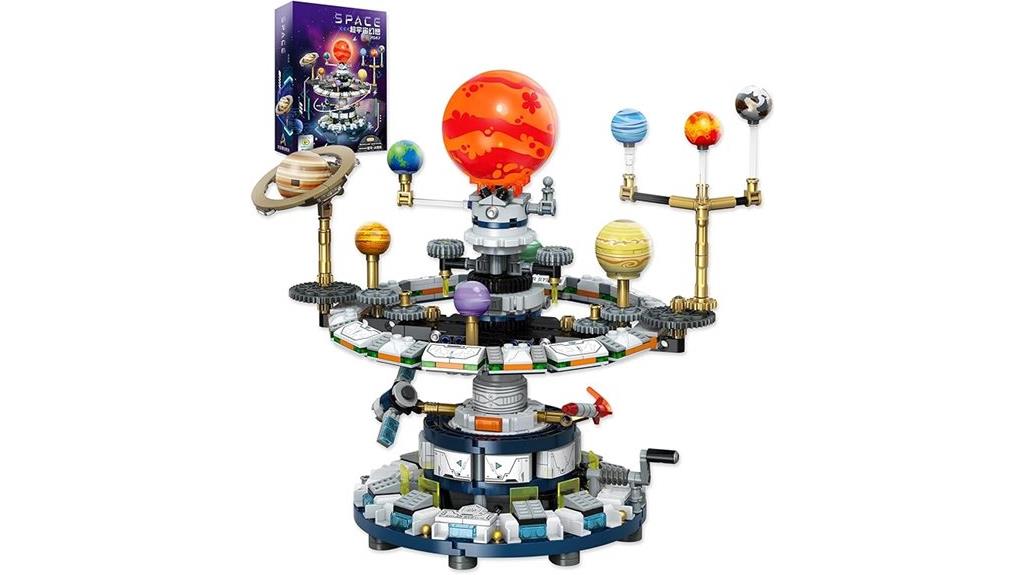
If you’re looking for a hands-on way to introduce kids to astronomy, the Rotatable Solar System Building Set is an excellent choice, especially for children aged 6 and up. This set features a handle-driven planetary gear system that simulates the orbits of the eight planets around the sun. It visually demonstrates planetary sizes, colors, and movements, making celestial mechanics engaging and easy to understand. Kids can actively build and rotate the planets, promoting learning about planetary motion, engineering, and space science. It’s a fun, screen-free activity that encourages patience, creativity, and family collaboration, making science both accessible and exciting.
Best For: children aged 6 and up who are interested in space, astronomy, and hands-on STEM learning experiences.
Pros:
- Engages children with interactive planetary movement and celestial mechanics
- Promotes STEM skills such as engineering, problem-solving, and scientific understanding
- Encourages screen-free, collaborative play that fosters patience and creativity
Cons:
- Assembly may be challenging for younger children without adult assistance
- The size of the set might require significant space for display and storage
- Limited to educational and space-themed exploration, may not appeal to all children’s interests
4M Solar System Planetarium Model

Looking for an engaging, hands-on way to introduce kids and teens to the wonders of our solar system? The 4M Solar System Planetarium (Model: 3427) is perfect. This glow-in-the-dark DIY kit lets children assemble and paint planets, creating a 16.5-inch solar mobile that’s both educational and fun. It includes planets, glow paint, and interactive components like Earth spinning and Moon orbiting. No batteries needed, making it simple to set up anywhere. It helps kids grasp planetary positions, orbits, and sequences through tactile learning. Rated 4.4 stars, it’s a popular, affordable STEM toy that fosters curiosity, understanding, and a love for space exploration.
Best For: parents, teachers, and space enthusiasts looking for an engaging, educational STEM activity to teach kids about the solar system through hands-on assembly and painting.
Pros:
- Encourages interactive learning with a tactile, 3D solar mobile design
- Includes glow-in-the-dark features that make the model visually appealing after dark
- Suitable for children aged 8 and up, promoting curiosity and understanding of space
Cons:
- The planets are not to scale, which may affect educational accuracy
- Some users find the small parts and paint quality less durable or detailed
- Excludes Pluto from the solar system model, which may disappoint some learners
Science Can Solar System for Kids, Talking Astronomy Solar System Model Kit

Children aged 3 to 12 who are curious about space will find the Science Can Solar System for Kids a fantastic educational tool. This engaging model projects the eight planets orbiting the sun onto walls or ceilings, transforming any room into a planetarium. It includes colorful slides showcasing planets, astronauts, and spacecraft, making learning interactive and fun. The toy also functions as a nightlight or flashlight, providing comfort at bedtime. Easy to assemble with click-in parts, it features educational facts in both English and Spanish. Overall, it’s a durable, user-friendly way to introduce children to astronomy while sparking their curiosity about the universe.
Best For: children aged 3-12 who are curious about space and want an engaging, educational, and interactive way to learn about the solar system.
Pros:
- Provides an interactive projection of the solar system that transforms any room into a planetarium.
- Includes educational facts in both English and Spanish, enhancing bilingual learning.
- Durable, easy to assemble, and serves as a nightlight or flashlight for added comfort.
Cons:
- May require careful assembly to ensure proper projection and functionality.
- Projection quality can vary based on surface and alignment; some users experience initial setup challenges.
- Batteries (3 AA) are not included, so additional purchase is necessary.
64 PCS Solar System Project Kit with Foam Balls and Accessories

The PCS Solar System Project Kit with Foam Balls and Accessories is an excellent choice for educators and parents seeking an extensive, hands-on learning tool for young children. This kit includes foam discs representing planets, a sun, foam balls, stars, bamboo sticks, flags, paints, brushes, and an instruction manual. Designed for children aged 3-5, it offers a fun way to explore planetary arrangements, improve coordination, and develop artistic skills. Its durable materials and safe paints make it perfect for classroom or home use. Compact and portable, this kit simplifies solar system projects, making astronomy engaging and accessible for young learners.
Best For: educators, parents, and young children aged 3-5 seeking an engaging, hands-on solar system educational activity.
Pros:
- Comprehensive set with all necessary materials for easy assembly and learning.
- Durable, safe foam and non-toxic acrylic paints suitable for young children.
- Promotes STEM skills, creativity, and understanding of planetary arrangements through fun, interactive projects.
Cons:
- Some users may need to purchase additional supplies like extra paint or skewers for more detailed projects.
- The recommended age is 6+, so younger children may require adult supervision or assistance.
- Limited variety of paint colors included, which might restrict creative options without additional purchases.
48PCS Solar System Foam Ball Kit with Polystyrene Spheres, Sticks, Flags, Pigments, Brushes, and Paint Tray
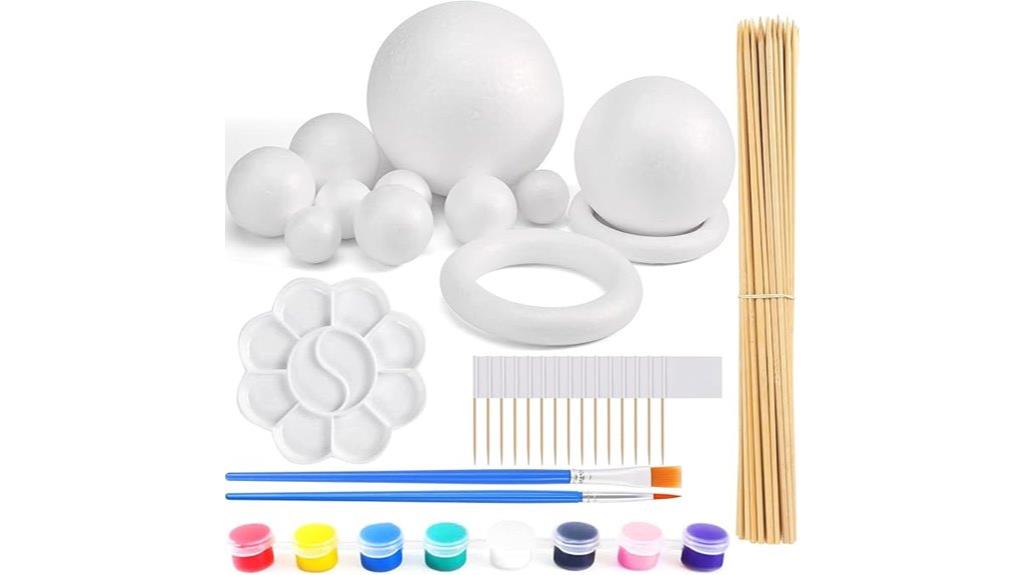
If you’re seeking an all-in-one kit to make learning about our solar system both fun and interactive, the PCS Solar System Foam Ball Kit is an excellent choice. It includes 48 foam balls of various sizes representing planets, a foam ring for Saturn, bamboo sticks, toothpick flags for labeling, and vibrant acrylic pigments with brushes and a paint tray. Made from lightweight, high-density polystyrene, the kit is safe and easy to paint. Assembly is simple—no glue needed—letting kids create accurate, colorful models. It’s perfect for classroom projects, crafts, or home learning, making space education engaging and hands-on.
Best For: educators, parents, and students seeking a comprehensive and engaging way to learn about the solar system through hands-on activities and creative modeling.
Pros:
- Includes all necessary components (foam balls, sticks, flags, pigments, brushes, tray) for a complete solar system project.
- Made from lightweight, non-toxic, and safe materials suitable for children aged 8 and above.
- Enhances learning through interactive painting and assembly, fostering creativity and understanding of planetary proportions.
Cons:
- Limited paint quantity may require additional pigments for multiple projects or detailed painting.
- Some assembly may require additional support or base for stability during display.
- The kit might not include detailed instructions, requiring adult supervision or supplementary guidance for best results.
Wooden Solar System Model Board for Kids
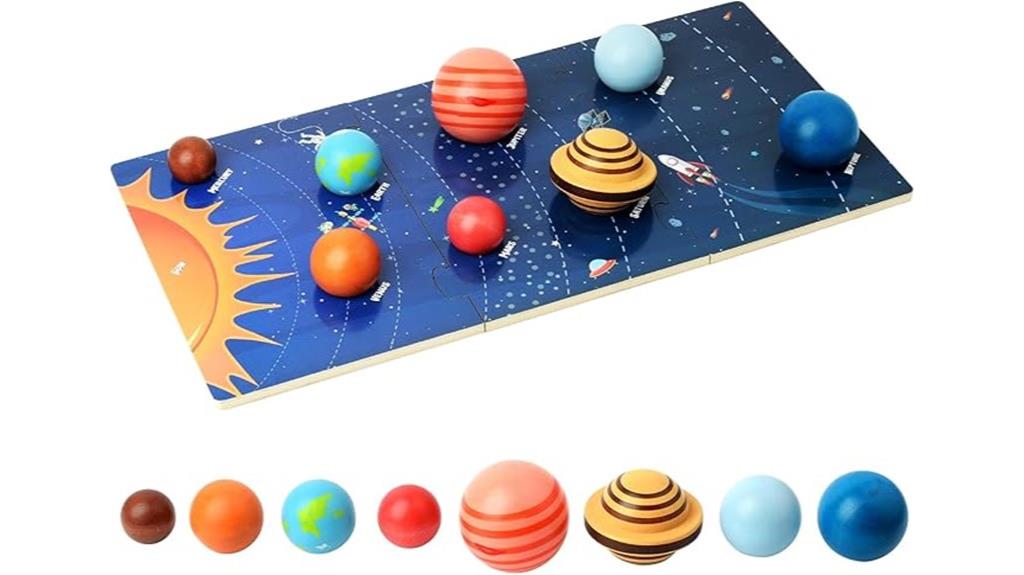
The Wooden Solar System Model Board is an excellent choice for young kids aged 4-8 who are just starting to explore space and science. It features eight wooden planet balls, each representing a different planet, along with explanatory flashcards to deepen understanding. The set also includes three puzzles that assemble into a colorful, cartoon-style solar system, making learning interactive and fun. Crafted from sturdy, smooth wood, it’s safe for little hands and easy to handle. This engaging toy sparks curiosity about the universe, improves spatial awareness, and makes science accessible, perfect for both educational settings and space-themed gifts.
Best For: young children aged 4-8 who are interested in learning about the solar system and space through engaging, educational toys.
Pros:
- Made from durable, smooth wood with no edges, ensuring safety for toddlers.
- Includes multiple interactive components such as planet balls, flashcards, and puzzles to enhance learning.
- Visually appealing, realistic planet representations that stimulate curiosity and spatial awareness.
Cons:
- May require adult supervision for younger children to ensure proper assembly and understanding.
- Limited to basic solar system concepts suitable for early learners; not advanced enough for older children.
- The size of the components might be small for very young children, posing a slight choking hazard if not supervised.
Playz Solar System Model Kit for Kids
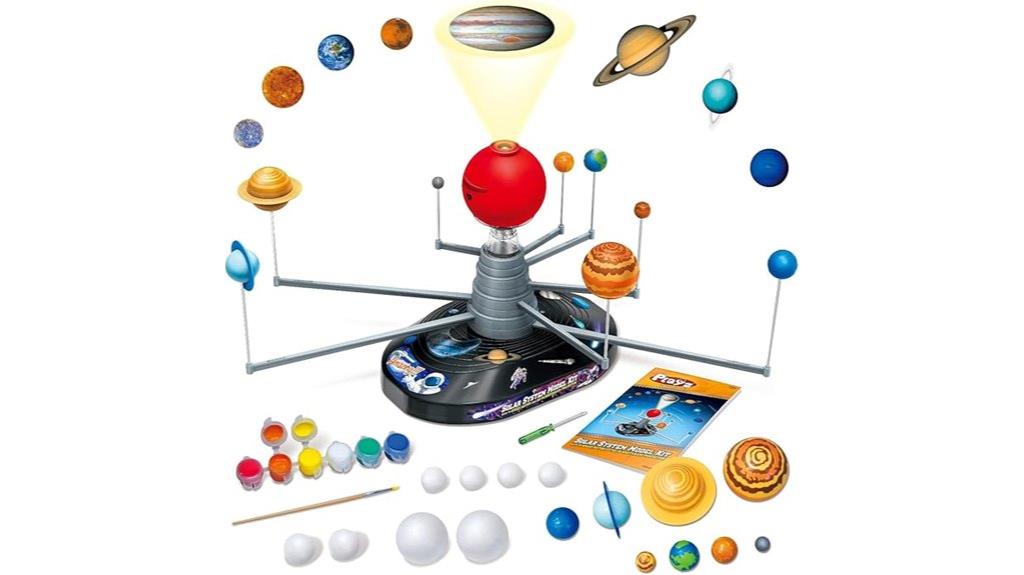
Are you looking for an engaging and educational way to teach kids about the solar system? The Playz Solar System Model Kit is perfect for children aged 8 and up. It features a motor-driven orrery, a HD planetarium projector, and 8 painted planets along with foam balls for painting. The large model helps kids visualize planetary sizes, orbits, and speeds, while the projector adds a fun nightlight element. Easy to assemble, it promotes hands-on learning about astronomy, physics, and engineering. Kids can paint their planets and explore space concepts creatively. Despite some noise and projection limits, this kit offers a thorough, fun way to spark curiosity about the universe.
Best For: children aged 8 and up, educators, and space enthusiasts seeking an engaging, hands-on way to learn about the solar system and astronomy.
Pros:
- Includes a motor-driven orrery, HD planetarium projector, and painted planets for a comprehensive learning experience
- Encourages creativity with foam balls and painting materials for personalized planets
- Large size and clear instructions make assembly suitable for kids and educational settings
Cons:
- Motor can be noisy during operation, which might be distracting
- Projection quality is limited due to short focal length, making detailed viewing challenging
- Some parts, like the projector, may have a short focal range, impacting image clarity on larger surfaces
Great Explorations, 3D Glow in the Dark Planets in a Tube, Ages 5 and Up
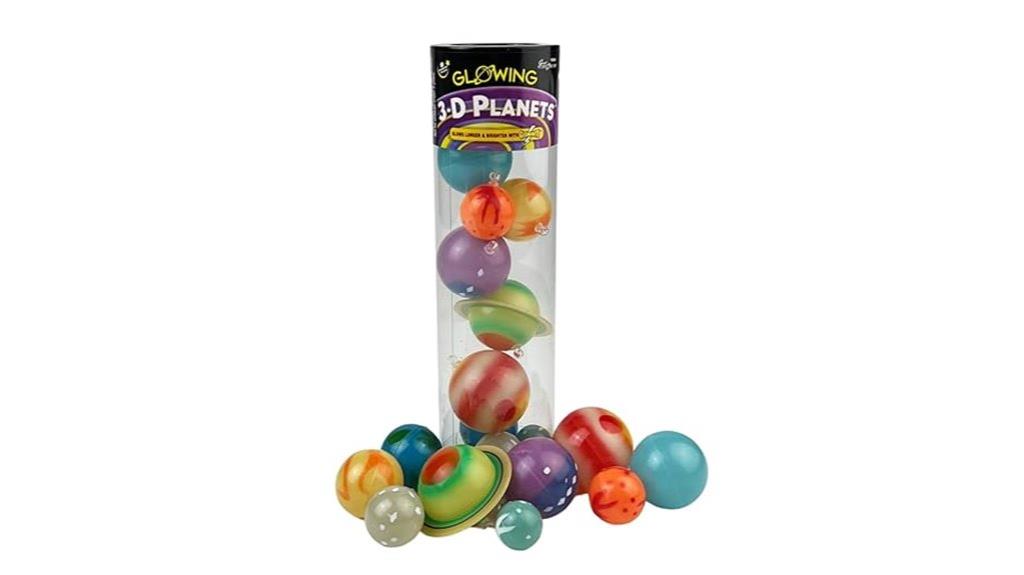
Great Explorations’ 3D Glow in the Dark Planets in a Tube is perfect for kids aged 5 and up who are curious about space. This kit features eight colorful, three-dimensional planets plus a glowing Pluto, creating a vibrant cosmic display. The planets emit a bright, mesmerizing glow that enhances visual interest and sparks imagination. Easy to set up with adhesive putty and 25 feet of string, it allows kids to customize their universe. Not only fun, but educational too, it encourages exploration and curiosity about the solar system. It’s an engaging way to transform any room into an awe-inspiring, glowing space scene.
Best For: kids aged 5 and up who are curious about space and enjoy interactive, educational, and creative activities.
Pros:
- Bright, mesmerizing glow-in-the-dark planets that enhance visual interest
- Includes all necessary components for easy and customizable display
- Encourages learning and curiosity about the solar system in a fun, hands-on way
Cons:
- Requires adhesive putty and string, which may need replacement or adjustment over time
- Limited to a specific set of planets, which may not cover the entire solar system
- Glow intensity and duration may vary depending on light exposure and age of the glow material
35PCS Solar System Model Kit with Foam Balls, Paints, Brushes, and Accessories
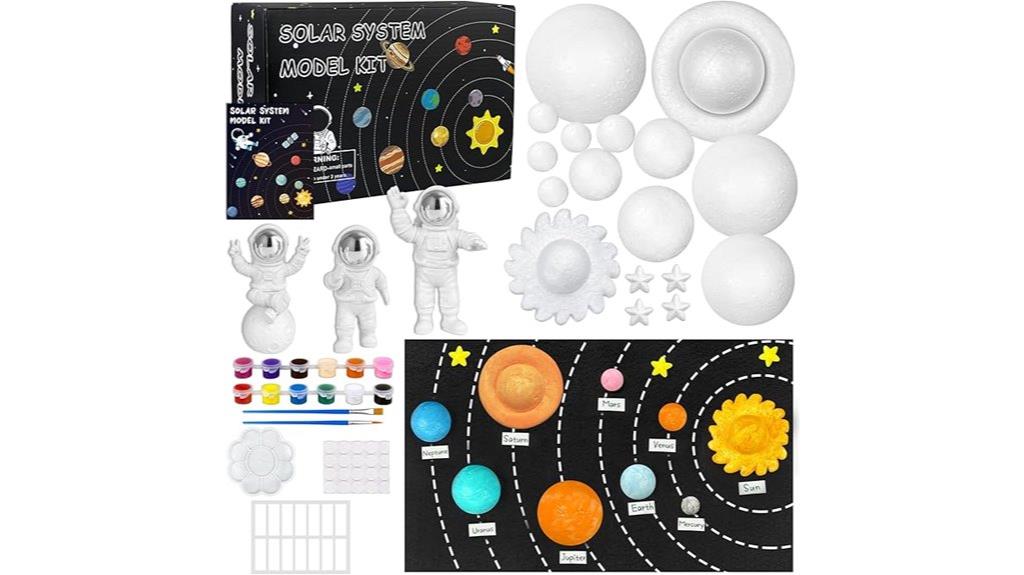
If you’re looking for a hands-on way to teach kids about the solar system, the PCS Solar System Model Kit is an ideal choice. It includes foam balls, paints, brushes, and accessories to create a detailed, wall-hanging model. The kit features 14 foam planets, stars, astronaut ornaments, and an instruction manual to guide assembly. It promotes learning about planetary orbits, improves fine motor skills, and encourages creativity. The compact display makes it perfect for small spaces or classrooms. Overall, it offers a fun, educational experience that combines science with art, making astronomy engaging and accessible for learners of all ages.
Best For: educators, parents, and students seeking a hands-on, educational, and creative way to learn about the solar system through DIY assembly and artistic decoration.
Pros:
- Encourages hands-on learning and enhances understanding of planetary orbits
- Promotes fine motor skills, hand-eye coordination, and creativity
- Space-saving design makes it suitable for small living spaces and classrooms
Cons:
- May require adult supervision for younger children during assembly and painting
- Limited to wall-hanging display, which might not suit those seeking 3D models
- Assembly and painting can be time-consuming for users looking for quick projects
Nine Planets DIY Solar System Model Kit for Kids
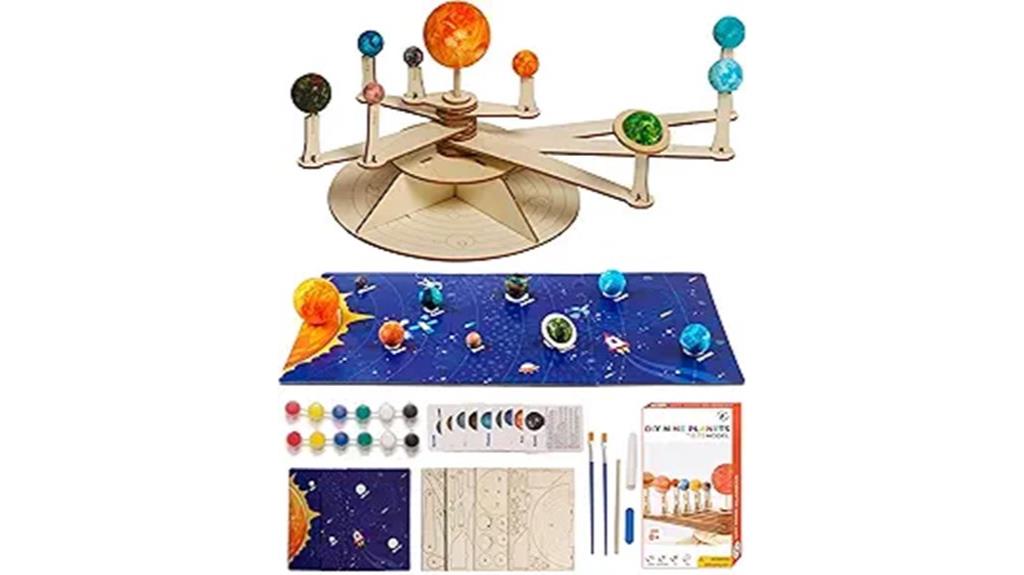
Looking for a hands-on way to introduce kids to our solar system? The Nine Planets DIY Solar System Model Kit is perfect for children aged 8 and up. It includes a wooden model, paint, brushes, fact cards, and a puzzle, allowing kids to build, paint, and learn about all nine major planets. The activity takes about 1-2 hours and promotes creativity, curiosity, and understanding of space. This engaging kit supports educational growth while making science fun. It’s ideal for classroom projects, science fairs, or personal displays, helping children connect with astronomy through hands-on exploration.
Best For: parents, teachers, and kids aged 8 and up who want an engaging, educational, and creative introduction to the solar system through hands-on building and learning activities.
Pros:
- Encourages hands-on learning and artistic expression with painting and assembling the model.
- Includes comprehensive educational materials like fact cards to enhance understanding of each planet.
- Suitable for various uses such as science fairs, classroom projects, or personal displays, making it versatile.
Cons:
- Assembly and painting may take longer than 1-2 hours for some children, depending on skill level.
- Requires adult supervision or assistance for younger children to ensure proper assembly and safety.
- Limited to the nine major planets, so it doesn’t include dwarf planets or additional celestial bodies.
Dan&Darci Inflatable Solar System Planets for Kids
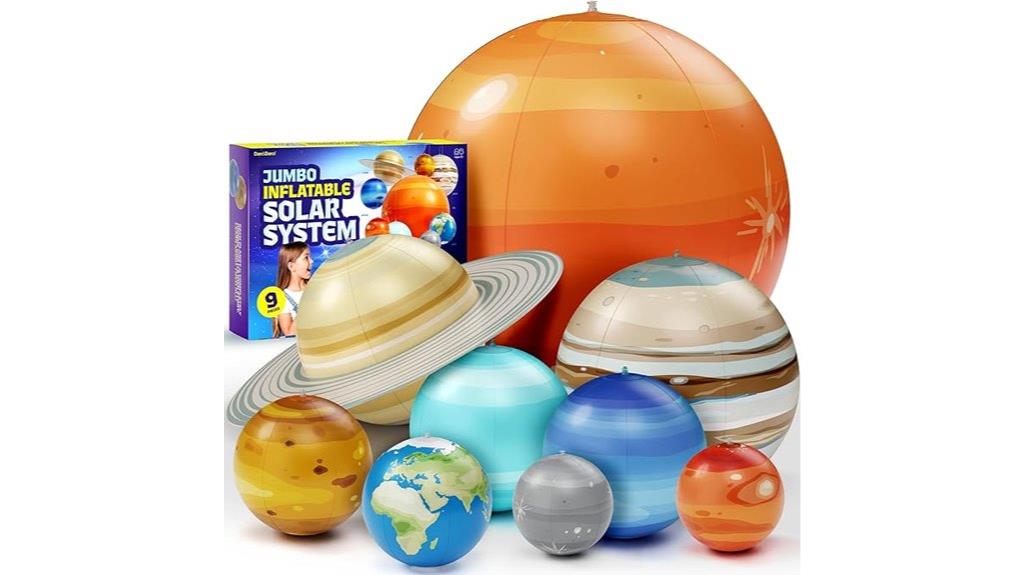
The Dan&Darci Inflatable Solar System is an excellent choice for educators, parents, and space enthusiasts who want to make learning about planets engaging and hands-on. These jumbo inflatables include all eight planets plus the sun, making the solar system vivid and easy to visualize. Kids can hang planets from ceilings using built-in loops, creating an immersive experience. The set also includes galaxy learning cards with key facts, enhancing educational value. Made from durable, kid-safe materials, they’re easy to deflate and store. While some minor issues like sagging rings exist, overall, they offer bright colors, large sizes, and fun, tactile learning for classrooms and parties.
Best For: educators, parents, and space enthusiasts seeking an engaging, hands-on way to teach and celebrate the solar system with kids.
Pros:
- Bright, vibrant colors and large sizes make planets visually appealing and easy to see.
- Includes educational galaxy learning cards with key facts to enhance space knowledge.
- Durable, kid-safe materials allow for repeated use and easy deflation for storage.
Cons:
- Some planets, like Saturn, may have sagging rings or minor structural issues.
- The sun may lose air over time, affecting its shape and appearance.
- Seams and rings can rip or sag with frequent handling or rough play.
Dan&Darci 360° Orbiting Solar System Model Kit for Kids
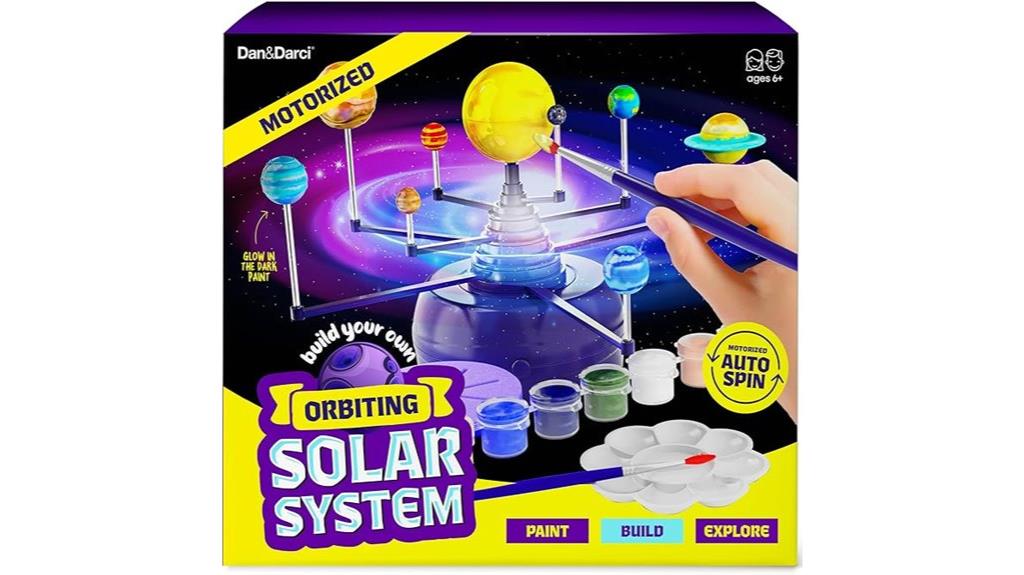
Kids fascinated by space and art will find the Dan&Darci 360° Orbiting Solar System Model Kit perfect for combining creativity with scientific discovery. This kit lets children create, paint, and assemble a solar system with motorized orbiting planets, including the Sun and all eight planets. It features glow-in-the-dark paints, brushes, and easy instructions, making learning about planetary motion fun and interactive. Standing 6.5 inches tall with a 13.5-inch orbit diameter, it’s ideal for display and hands-on family activities. While some reviews mention minor issues, overall, it offers an engaging way for kids to explore astronomy through art and STEM.
Best For: children aged 4-12 who are interested in space, art, and science, and want an engaging, hands-on learning activity.
Pros:
- Promotes STEM learning by exploring planetary motion and astronomy
- Encourages creativity through painting and assembly with glow-in-the-dark paints
- Suitable for family fun and educational display with motorized orbiting planets
Cons:
- Some users report missing or duplicate planet signs, causing confusion
- The assembly process can be delicate and may require careful handling
- Instructions may be incomplete or unclear, making assembly more challenging
Factors to Consider When Choosing a Solar System Model

When picking a solar system model, I consider factors like age appropriateness and how easy it is to assemble. I also look at the quality of educational content, visual effects, and safety standards to guarantee it’s suitable and engaging. These points help me choose a model that’s both fun and informative for learners.
Age Appropriateness Needed
Choosing the right solar system model depends heavily on the child’s age and developmental level. For younger kids aged 3-5, I recommend simple kits with fewer parts, easy to assemble, and made from non-toxic materials. These models match their limited fine motor skills and attention span. For older children, like those aged 8-12, more detailed models with multiple parts are suitable, as they can handle assembly and understand more complex concepts. I also look for age-appropriate educational content, such as beginner explanations or fact posters, to match their learning level. Safety is vital—materials must be non-toxic and safe for handling, especially for younger children who might put objects in their mouths. Ensuring age-appropriate models makes learning fun, safe, and effective.
Educational Content Quality
To guarantee the educational value of a solar system model, it’s essential to select one that provides accurate and scientifically supported information about planetary sizes, orbits, and features. Reliable models include detailed explanations or fact sheets about each planet, enriching learning beyond visual appeal. Engaging educational elements like facts, trivia, or interactive components help deepen understanding of space concepts. It’s also important that the content is age-appropriate, clear, and easily understandable, ensuring learners grasp complex astronomical ideas without confusion. I look for models endorsed by reputable educational organizations or scientists, as this guarantees the accuracy and quality of the information presented. A well-designed model with high-quality educational content transforms a simple visual tool into a powerful learning resource, inspiring curiosity and a deeper appreciation for our solar system.
Assembly Complexity Level
Selecting a solar system model involves considering how easy or challenging it is to assemble. Some models are designed for kids, featuring simple, child-friendly construction with pre-assembled parts or motorized elements that make setup quick and straightforward. These are ideal for beginners or younger children who want to learn without frustration. On the other hand, detailed models with numerous small pieces or complex alignment steps can be more challenging, requiring patience and precision—better suited for older children or teens with some assembly experience. The availability of clear instructions, visual guides, and labels can greatly simplify the process, making it more manageable. Additionally, tools or accessories included in the kit, like screwdrivers or gears, can add to the complexity, so consider your comfort level and patience when choosing.
Visual and Glow Effects
Have you ever wondered what makes a solar system model visually striking in low light? The glow effects depend heavily on the quality of glow-in-the-dark paint used. Multiple colors and layered accents create more vibrant, eye-catching visuals in dim settings. The size and placement of planets also matter—they reflect or emit light better when positioned thoughtfully, boosting their visual appeal. Adding LED or light-up components can dramatically enhance glow intensity and overall impact. Additionally, adjustable models allow you to modify positioning, ensuring glow effects are visible from different angles and distances. These features make the model not just educational but also mesmerizing, especially in darker environments. Considering these factors helps you select a model that’s both visually impressive and fun to explore.
Material Safety Standards
When choosing a solar system model, prioritizing material safety is vital to guarantee it’s suitable for all users, especially children. I always check that the materials meet safety standards like being non-toxic, BPA-free plastics, and child-safe paints to prevent health hazards. It’s important to verify compliance with certifications such as ASTM, CE, or FDA, ensuring the model adheres to strict safety protocols. I also look for models made from durable, non-flammable materials to reduce fire risks during assembly and use. Additionally, I ensure that paints, glues, and accessories are odorless, non-toxic, and safe for skin contact, especially for young children. Finally, all parts should be securely attached, with no sharp edges or small components that could cause choking or injury.
Size and Space Fit
Ensuring your chosen solar system model fits well in your display space is key to creating an effective and safe educational environment. First, measure the available area to confirm the model won’t overcrowd the space. Consider the size of the planets and components to ensure they are proportionate and appropriate for your display. Larger models offer better detail and visibility but need more room, while smaller models are easier to handle and fit into limited spaces. Before buying, check the dimensions against your shelves, desks, or classroom setup to avoid surprises. Also, leave enough clearance around the model to allow safe handling, viewing, and demonstrations. Proper sizing ensures an engaging, safe, and practical educational experience without sacrificing space or detail.
Price and Value
Choosing the right solar system model involves balancing cost with educational value. Prices can range from under $20 for basic models to over $100 for detailed, motorized setups. Higher-priced models often include features like orbiting planets, glow-in-the-dark elements, and educational accessories, which enhance learning. When evaluating value, consider the quality of materials, accuracy of planetary details, and the completeness of components relative to the price. Cheaper models may lack durability or detailed features but still offer basic educational benefits, especially for younger learners or casual use. Comparing costs against educational benefits, build quality, and included features helps determine if a model provides good value. Ultimately, selecting a model that fits your budget without sacrificing essential educational qualities is key.
Frequently Asked Questions
What Age Range Is Most Suitable for Each Solar System Model?
I find that small, simple models are perfect for young children, ages 4 to 8, because they’re easy to handle and understand. For ages 9 to 12, more detailed models work well, sparking curiosity and deeper learning. Teenagers can explore complex, accurate models that include scientific details. Tailoring the model to the age guarantees engagement and effective learning, making the solar system come alive for every age group.
Are These Models Compatible With Other STEM Educational Tools?
Yes, these models are compatible with other STEM educational tools. I find that combining them with interactive apps, diagrams, and hands-on experiments enhances learning. You can easily integrate them into lessons on astronomy, physics, or engineering. The models serve as tangible references, making abstract concepts more concrete. This compatibility encourages active engagement and helps students develop a well-rounded understanding of scientific principles through diverse, complementary tools.
How Durable Are the Materials Used in These Solar System Kits?
The materials in these solar system kits are quite durable, designed to withstand regular handling by students. I find that the plastic and rubber components resist cracking and fading over time, making them suitable for classroom use. While they’re sturdy enough for active play, I recommend gentle handling and proper storage to keep them looking new. Overall, they hold up well through repeated lessons and student engagement.
Can These Models Be Customized or Expanded Over Time?
Yes, these models can definitely be customized and expanded over time. I love that many kits are modular, allowing me to add planets or features as I learn more. Some models even let me swap out parts or upgrade components. This flexibility keeps the learning process engaging and allows me to tailor the model to my evolving understanding of the solar system, making it a versatile educational tool.
Do the Models Include Educational Guides or Lesson Plans?
Yes, many solar system models include educational guides or lesson plans. I find these resources incredibly helpful because they offer structured activities and facts that enhance learning. When I choose a model, I look for one that comes with detailed guides, so I can easily incorporate it into lessons or fun projects. These materials make understanding the solar system more engaging and accessible for learners of all ages.
Conclusion
Choosing the right solar system model turns learning into an adventure—like opening a door to the universe itself. Whether you prefer a hands-on building set or a talking planetarium, each option sparks curiosity and wonder. Remember, the perfect model isn’t just about accuracy; it’s about igniting a lifelong fascination with space. After all, isn’t it magical how a tiny model can inspire a universe of exploration within us?




